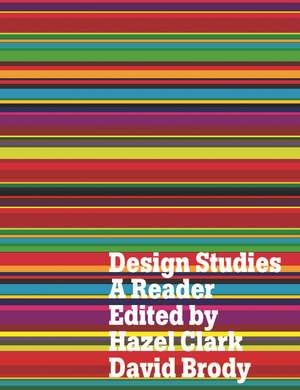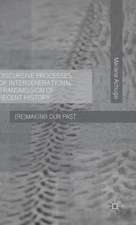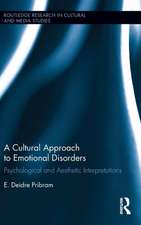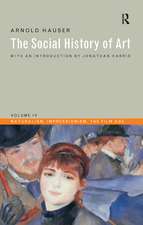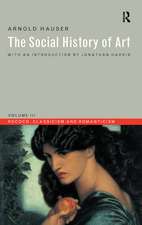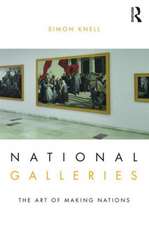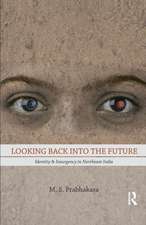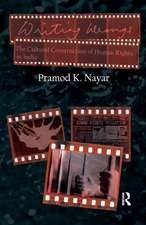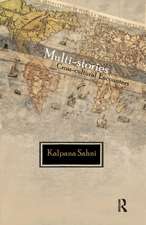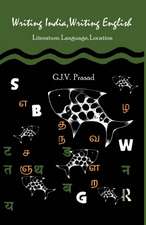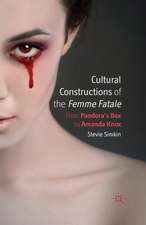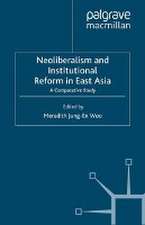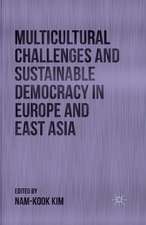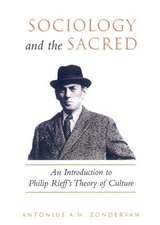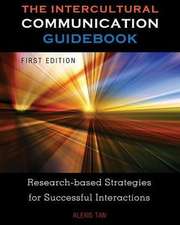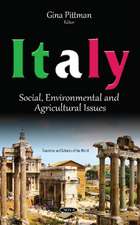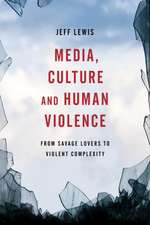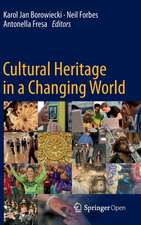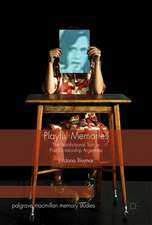Design Studies: A Reader
en Limba Engleză Paperback – 31 mai 2023
Preț: 233.00 lei
Preț vechi: 266.90 lei
-13% Nou
Puncte Express: 350
Preț estimativ în valută:
44.59€ • 46.20$ • 37.21£
44.59€ • 46.20$ • 37.21£
Carte disponibilă
Livrare economică 01-15 martie
Livrare express 15-21 februarie pentru 69.08 lei
Preluare comenzi: 021 569.72.76
Specificații
ISBN-13: 9781350352414
ISBN-10: 1350352411
Pagini: 608
Ilustrații: 50 b&w illustrations
Dimensiuni: 189 x 244 x 35 mm
Greutate: 0.45 kg
Editura: Bloomsbury Publishing
Colecția Bloomsbury Visual Arts
Locul publicării:London, United Kingdom
ISBN-10: 1350352411
Pagini: 608
Ilustrații: 50 b&w illustrations
Dimensiuni: 189 x 244 x 35 mm
Greutate: 0.45 kg
Editura: Bloomsbury Publishing
Colecția Bloomsbury Visual Arts
Locul publicării:London, United Kingdom
Caracteristici
Also available in hardback, 9781847882370 £60.00 (May, 2009)
Notă biografică
Hazel Clark is Professor of Design Studies and Fashion Studies and David Brody is Professor of Design Studies, both at Parsons School of Design, The New School, USA.
Cuprins
General Introduction, Hazel Clark and David Brody SECTION I: HISTORY OF DESIGN Section Introduction I.1: DESIGN HISTORIES Part Introduction 1. Nikolaus Pevsner, Pioneers of Modern Design 2. Adrian Forty, Design, Designers and the Literature of Design 3. Matthew Turner, Early Modern Design in Hong Kong 4. Lucila Fernández Uriate, Modernity and Postmodernity from Cuba I.2: DESIGN HISTORY AS A DISCIPLINE Part Introduction 5. Victor Margolin, Design History and Design Studies 6. John Walker, Defining the Object of Study 7. Judy Attfield, FORM/female FOLLOWS FUNCTION/male 8. Denise Whitehouse, The State of Design History as a Discipline Annotated Guide to Further Reading SECTION II: DESIGN THINKING Section Introduction II.1: DESIGN PHILOSOPHIES AND THEORIES Part Introduction 9. Buckminster Fuller, Speculative Prehistory of Humanity 10. John Chris Jones, What is Designing? 11. Louis Bucciarelli, Designing Engineers 12. Henry Petroski, Success and Failure in Design 13. Richard Buchanan, Wicked Problems in Design ThinkingII.2: DESIGN RESEARCH Part Introduction 14. Herbert Simon, Understanding the Natural and Artificial Worlds 15. Donald Schön, Designing; Rules, Types and Worlds 16. Susan Squires, Discovery Research II: 3 DESIGN COMMUNICATIONS Part Introduction 17. Eric van Schaak, The Division of Pictorial Publicity in World War I 18. D.J Huppatz, Globalizing Corporate Identity in Hong Kong 19. Shirley Teresa Wajda, Kmartha Annotated Guide to Further Reading SECTION III: THEORIZING DESIGN AND VISUALITY Section Introduction III.1: AESTHETICS Part Introduction 20. Arthur C. Danto, Aesthetics and the Work of Art 21. Jean Baudrillard, Design and Environment 22. Reyner Banham, Taking it with You III.2: ETHICS Part Introduction 23. Zygmunt Bauman, In the Beginning was Design 24. Susan Szenasy, Ethical Design Education 25. AIGA/Rick Poyner, First Things First 2000 26. Clive Dilnot, Ethics in Design: 10 Questions III.3: POLITICS Part Introduction 27. Karl Marx, The Fetishism of Commodities and the Secret Thereof 28. Pierre Bourdieu, The Aesthetic Sense and the Sense of Distinction 29. Naomi Klein, No Logo 30. Dick Hebdige, Subculture and Style 31. John Stones, Incendiary Devices 32. Gui Bonsiepe, Design and Democracy III.4 MATERIAL CULTURE AND SOCIAL INTERACTIONS Part Introduction 33. Jules Prown , Mind in Matter 34. Daniel Miller , The Artefact as Manufactured Object 35. Michel Foucault, Panopticism 36. Michel de Certeau, Walking in the City 37. Erving Goffman, The Presentation of Self in Everyday Life Annotated Guide to Further Reading SECTION IV: IDENTITY AND CONSUMPTION Section Introduction IV.1: VIRTUAL IDENTITY AND DESIGN Part Introduction 38. Donna Haraway, A Cyborg Manifesto 39. Katie Salen and Eric Zimmerman, Introducing Cybernetic Systems 40. Justin Clark, Get a Life41. Gavin O'Malley, American Apparel IV.2: GENDER AND DESIGN Part Introduction 42. Cheryl Buckley, Made in Patriarchy 43. Barbara Ehrenreich and Annette Fuentes, Life on the Global Assembly Line 44. Hazel Clark The Difference of Female Design IV.3: CONSUMPTION Part Introduction 45. Mary Douglas and Baron Isherwood, Technology and Consumption 46. Daniel Harris, Quaintness 47. Sarah Lichtman, Do-It-Yourself Security 48. W.F. Haug, Critique of Commodity Aesthetics 49. Heike Jenß, Fashioning Uniqueness: Mass-Customization and Commodization of Identity Annotated Guide to Further Reading SECTION V: LABOR, INDUSTRIALIZATION AND NEW TECHNOLOGY Section Introduction V.1: LABOR AND THE PRODUCTION OF DESIGN Part Introduction 50. John Styles, Manufacturing Consumption and Design 51. Paul du Gay, et al, The Sony Walkman 52. Stuart Walker, Integration of Scale V.2: INDUSTRIALIZATION AND POST INDUSTRIALIZATION Part Introduction 53. David Brett, Drawing and the Ideology of Industrialization 54. Margaret Crawford, The 'New' Company Town 55. Frederick Winslow Taylor, The Principles of Scientific Management 56. Abraham Moles, Design and Immateriality V.3: NEW DESIGN AND NEW TECHNOLOGIES Part Introduction 57. Bradley Quinn, Hussein Chalayan, Fashion and Technology 58. Donald Norman, What's Wrong with the PC? 59. Vicente Rafael, The Cell Phone and the Crowd 60. Theodor Adorno, Do Not Knock Annotated Guide to Further Reading SECTION VI: DESIGN AND GLOBAL ISSUES Section Introduction VI.1: GLOBALIZATION Part Introduction 61. Arjun Appadurai, Modernity at Large 62. Hugh Aldersey-Williams, Globalism, Nationalism, and Design 63. Guy Julier, Responses to Globalisation VI.2: EQUALITY AND SOCIAL JUSTICE Part Introduction 64. Kate Stohr, Self-Help and Sites-and Services Programs 65. John Hockenberry, The Re-Education of Michael Graves 66. Ezio Manzini, A Cosmopolitan Localism 67. Earl Tai, Design Justice VI.3: SUSTAINABILITY Part Introduction 68. William McDonough and Michael Braungart, A Question of Design 69. Victor Papanek, Designing for a Safe Future 70. Trish Lorenz, British Designers Accused of Creating Throw-Away Culture Annotated Guide to Further Reading SECTION VII: DESIGN THINGS Section Introduction71. Wava Carpenter, The Eames Lounge: The Difference between a Design Icon and Mere Furniture 72. Dipti Bhagat, The Tube Map (The London Underground Map) 73. Susan Yelavich, Swatch 74. Catherine Walsh, Architecture and Cultural Identity: The Case of the Petronas Towers in Kuala Lumpur 75. R. Roger Remington, Helvetica: Love it or Leave it 76. Shirley Teresa Wajda, The Architect and the Teakettle 77. Greg Votolato, Bullets and Beyond (The Shinkanzen) 78. Alison Gill, Sneakers 79. Bess Williamson, The Bicycle: Considering Design in Use 80. Gerard Goggin, Cell Phone Annotated Guide to Further Reading Bibliography
Recenzii
Incredibly inclusive, this is essential reading for students and teachers of Design Studies in any context. A superlative collection of authoritative contributions from many of the most influential writers on design, past and present.
A book that works for students or anyone else with the slightest interest in design.
A critical snapshot of what's vital now in global comparative critical thinking on Design. The clearly structured and framed sets of key essays disclose the full reach and power of the myriad acts of designing that create our realities and, increasingly, narrow our future options.
The Reader combines new interpretations with influential texts that have shaped Design thinking over the last thirty years. It shows how Design is becoming more complex and how the emerging discipline of Design Studies has risen to this challenge. It will be an essential resource for students.
The Reader will become a standard reference for the subject. It establishes the field for all those interested in Design and its impact on the contemporary world. The Reader offers an informed overview of ways of engaging with the central themes of Design such as ethics, globalization, identity and gender.
An extraordinarily valuable resource for students in all areas of Design. It opens up endless fields of inquiry and also affirms 'Design Studies' as the only theoretical framework which encompasses all the richness and multiplicity of Design both conceptually and globally.
A wonderful and richly engaging book that would be invaluable to any student both at undergraduate and postgraduate levels of study to draw upon as a one-stop companion and reliable point of reference.
As a design educator, I've been waiting for a smart compilation of design essays for my graduate 3D design students. Until now, I've used my own mix of 'greatest hits' essays to inform our reading seminars. This year I began using this compilation with my graduate students. I like the way the book is structured by contemporary topics. The content is smart, contemporary and concise - excerpting the most relevant reading from each essay. I'd recommend this book to any student with an interest in the intellectual-big-picture of design.
If you're looking to do a little self-education this fall, this just might be the book for you.
Provides a great deal of food for thought for beginning design students from numerous subdisciplines and is also a good refresher for more advanced scholars.
In totality [Design Studies is] more than just a teaching or study resource. As [it] advocate[s] that the production, consumption and mediation of designed objects and images affect everyone, [it] will be of interest to both informed and general readerships... [A great strength of Design Studies is] the effective demonstration that design analysis and history is not an elitist, purely academic pursuit, but essential to consideration of society and its cultural expressions in the very broadest sense.
A book that works for students or anyone else with the slightest interest in design.
A critical snapshot of what's vital now in global comparative critical thinking on Design. The clearly structured and framed sets of key essays disclose the full reach and power of the myriad acts of designing that create our realities and, increasingly, narrow our future options.
The Reader combines new interpretations with influential texts that have shaped Design thinking over the last thirty years. It shows how Design is becoming more complex and how the emerging discipline of Design Studies has risen to this challenge. It will be an essential resource for students.
The Reader will become a standard reference for the subject. It establishes the field for all those interested in Design and its impact on the contemporary world. The Reader offers an informed overview of ways of engaging with the central themes of Design such as ethics, globalization, identity and gender.
An extraordinarily valuable resource for students in all areas of Design. It opens up endless fields of inquiry and also affirms 'Design Studies' as the only theoretical framework which encompasses all the richness and multiplicity of Design both conceptually and globally.
A wonderful and richly engaging book that would be invaluable to any student both at undergraduate and postgraduate levels of study to draw upon as a one-stop companion and reliable point of reference.
As a design educator, I've been waiting for a smart compilation of design essays for my graduate 3D design students. Until now, I've used my own mix of 'greatest hits' essays to inform our reading seminars. This year I began using this compilation with my graduate students. I like the way the book is structured by contemporary topics. The content is smart, contemporary and concise - excerpting the most relevant reading from each essay. I'd recommend this book to any student with an interest in the intellectual-big-picture of design.
If you're looking to do a little self-education this fall, this just might be the book for you.
Provides a great deal of food for thought for beginning design students from numerous subdisciplines and is also a good refresher for more advanced scholars.
In totality [Design Studies is] more than just a teaching or study resource. As [it] advocate[s] that the production, consumption and mediation of designed objects and images affect everyone, [it] will be of interest to both informed and general readerships... [A great strength of Design Studies is] the effective demonstration that design analysis and history is not an elitist, purely academic pursuit, but essential to consideration of society and its cultural expressions in the very broadest sense.
